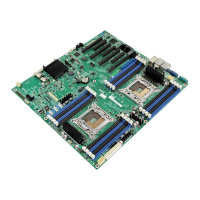Technology Support Intel® Server Board S2600CO Family TPS
44 Revision 1.0
Intel order number G42278-002
information about VT-x, VT-d, and VT-c, a good reference is Enabling Intel
®
Virtualization
Technology Features and Benefits White Paper.
4.3 Intel
®
Intelligent Power Node Manager
Data centers are faced with power and cooling challenges that are driven by increasing
numbers of servers deployed and server density in the face of several data center power and
cooling constraints. In this type of environment, Information Technology (IT) needs the ability to
monitor actual platform power consumption and control power allocation to servers and racks in
order to solve specific data center problems including the following issues:
Table 13. Data Center Problems
Ability to monitor actual power consumption
•Control capability that can maintain a power budget to
enable dynamic power allocation to each server
Under-population of rack space
Control capability that can maintain a power budget to
enable increased rack population.
Control capability that can maintain a power budget to
ensure that a set energy cost can be achieved
Ability to monitor actual power consumption to enable
power usage modeling over time and a given planning
period
•Ability to understand cooling demand from a
temperature and airflow perspective
Detection and correction of hot spots
Control capability that reduces platform power
consumption to protect a server in a hot-spot.
Ability to monitor server inlet temperatures to enable
greater rack utilization in areas with adequate cooling.
The requirements listed above are those that are addressed by the C600 chipset Management
Engine (ME) and Intel
®
Intelligent Power Node Manager (NM) technology. The ME/NM
combination is a power and thermal control capability on the platform, which exposes external
interfaces that allow IT (through external management software) to query the ME about platform
power capability and consumption, thermal characteristics, and specify policy directives (for
example, set a platform power budget).
Node Manager (NM) is a platform resident technology that enforces power capping and thermal-
triggered power capping policies for the platform. These policies are applied by exploiting
subsystem knobs (such as processor P and T states) that can be used to control power
consumption. NM enables data center power management by exposing an external interface to
management software through which platform policies can be specified. It also implements
specific data center power management usage models such as power limiting, and thermal
monitoring.
The NM feature is implemented by a complementary architecture utilizing the ME, BMC, BIOS,
and an ACPI-compliant OS. The ME provides the NM policy engine and power control/limiting
functions (referred to as Node Manager or NM) while the BMC provides the external LAN link by
which external management software can interact with the feature. The BIOS provides system
power information utilized by the NM algorithms and also exports ACPI Source Language (ASL)
code used by OS-Directed Power Management (OSPM) for negotiating processor P and T state
changes for power limiting. PMBus-compliant power supplies provide the capability to
monitoring input power consumption, which is necessary to support NM.

